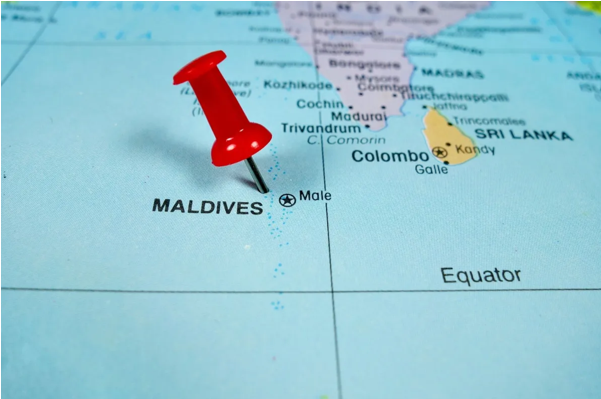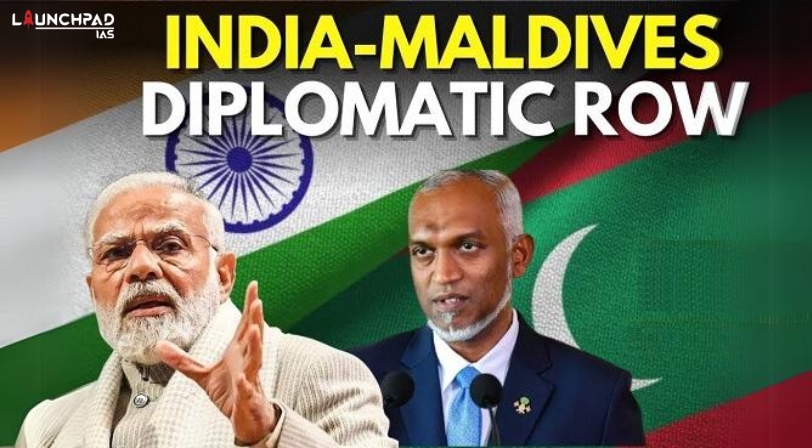Recent context:
- The latest trigger has been undiplomatic words used by ministers in Maldives against Prime Minister Narendra Modi in particular and Indians in general.
- The new government led by President Mohamed Muizzu asked India to withdraw military personnel and chose China for one of his first overseas visits.
- Maldives President Muizzu in his visit also urges China to reclaim the top spot in tourist arrivals which was dominated by India in the last few years.
- The incumbent government rode to power on an ‘India Out’ poll campaign.
- The release of a report by the EU Election Observation Mission of Maldives said, the ruling coalition in Maldives deployed anti-Indian sentiments and attempted to spread disinformation in the 2023 presidential elections in which Mr. Muizzu won.
- Maldives has also decided not to renew the agreement with India on a hydrographic survey of its waters.
- The agreement, signed in 2019, allowed India to conduct a hydrographic survey of the Maldivian territorial waters, and study and chart reefs, lagoons, coastlines, ocean currents, and tide levels.
Evolution of India and Maldives Relations
- The relationship between India and the Maldives has evolved over the years, influenced by geopolitical, economic, and strategic considerations.
- Early Diplomatic Ties (1965-1978): The Maldives gained independence from the British in 1965, and established diplomatic relations with India.
- India was one of the first countries to recognize the Maldives as an independent nation.
- Strategic Partnership (1978-1988): The signing of the Maritime Boundary Agreement in 1979 helped define the maritime boundaries between the two countries.
- Political Turbulence (1988-2008): The relationship faced challenges in 1988 when a coup attempt in the Maldives led to the intervention of Indian forces in Operation Cactus.
- India’s military intervention aimed to thwart the coup and preserve the Maldives’ political stability.
- This event temporarily strained diplomatic relations but was later resolved.
- Normalization and Economic Cooperation (2008-2013): In 2008, the Maldives experienced a peaceful political transition, and Mohamed Nasheed became the President.
- The relationship between India and the Maldives improved, focusing on economic cooperation, trade, and people-to-people ties.
- India provided developmental assistance to the Maldives, particularly in infrastructure projects and capacity building.
- Period of Strain (2013-2018): The relationship faced challenges during the presidency of Abdulla Yameen, with concerns over issues such as democratic backsliding, human rights, and a perceived tilt towards China.
- The Maldives’ growing engagement with China, including infrastructure projects under the Belt and Road Initiative, raised strategic concerns for India.
- Renewed Engagement (2018 Onward): The election of Ibrahim Mohamed Solih as the President of the Maldives in 2018 marked a shift in bilateral relations. There was a renewed emphasis on strengthening ties with India.
- The two countries reaffirmed their commitment to democratic values, and India extended financial assistance for various developmental projects.
Significance of Maldives for India:
- Location: Maldives’ proximity to the west coast of India (barely 70 nautical miles from Minicoy and 300 nautical miles from India’s West coast).

- Trade Route: Situated along crucial maritime trade routes between the Gulf of Aden and the Strait of Malacca, the Maldives acts as a “toll gate” for nearly half of India’s external trade and 80% of its energy imports.
- Strategic Importance: The Maldives is strategically located in the Indian Ocean, and its stability and security are of interest to India.
- Counterbalancing China: Maldives presents an opportunity for India to counterbalance China’s growing influence in the Indian Ocean, fostering regional balance of power.
- Economic partnership: India is one of the biggest investors and tourism markets for the Maldives, with significant trade and infrastructure projects underway.
- Defence: Defense and Security Cooperation: Since 1988, defence and security have been a major area of cooperation between India and the Maldives.
- A comprehensive Action Plan for Defence was also signed in 2016 to consolidate defence partnerships.
- Estimates suggest that almost 70 percent of Maldives’ defence training is done by India — either on the islands or in India’s elite military academies.
Significance of India for Maldives:
- Essential Commodities: India supplies Maldives with everyday essentials: rice, spices, fruits, vegetables, poultry, medicines, and life-saving drugs.
- Education: Every year, Maldivian students come to Indian higher educational institutions.
- Economic dependence: Of the Rs 50 crore total trade between India and Maldives in 2022, Rs 49 crore was India’s exports to Maldives. India emerged as Maldives’ second-largest trade partner in 2022.
- Disaster Relief Assistance: When a tsunami struck the islands in 2004, India was the first to send in help.
- In 2014 Male had a drinking water crisis as the major desalination plant broke down, India overnight airlifted drinking water to the islands.
- During the Covid-19 pandemic, India sent essential medicines, masks, gloves, PPE kits, and vaccines to the island country.
Challenges:
Political Instability
Domestic turmoil in the Maldives: Recent political upheavals and changes in government can create uncertainty and complicate long-term cooperation projects.
Chinese Influence
- Economic and infrastructure investments: China’s growing economic presence in the Maldives, evidenced by investments in infrastructure projects and debt-trap diplomacy, can be perceived as a challenge to India’s strategic interests in the region.
- Military ambitions: Chinese naval expansion and potential military ambitions in the Indian Ocean with active support from Maldives can raise concerns for India.
Security Concerns:
- Non-traditional threats: Piracy, terrorism, and drug trafficking remain concerns in the region, requiring continuous collaboration and intelligence sharing between India and the Maldives.
- Extremism and radicalization: The Maldives’ vulnerability to religious extremism and radicalization poses a security threat that necessitates joint efforts in countering such ideologies.
Economic and Environmental Concerns:
- Trade imbalance: The significant trade imbalance between India and the Maldives could lead to resentment and calls for diversifying trade partnerships.
- Impact of climate change: Both nations are highly vulnerable to climate change and rising sea levels, requiring coordinated efforts for adaptation and environmental protection.
Overcoming the challenges:
- Open and transparent communication: Regular dialogue at all levels can address concerns and build trust.
- Focus on common interests: Prioritizing areas like maritime security, climate change, and economic development can solidify the foundation of the partnership.
- Respect for sovereignty and non-interference: Both countries must respect each other’s internal affairs and avoid interference in domestic politics.
- Strengthening people-to-people ties: Cultural exchange programs and educational collaborations can foster deeper understanding and empathy.
- Addressing internal issues: Both India and the Maldives need to address domestic challenges like corruption and instability to project a positive image and foster a stable partnership.


